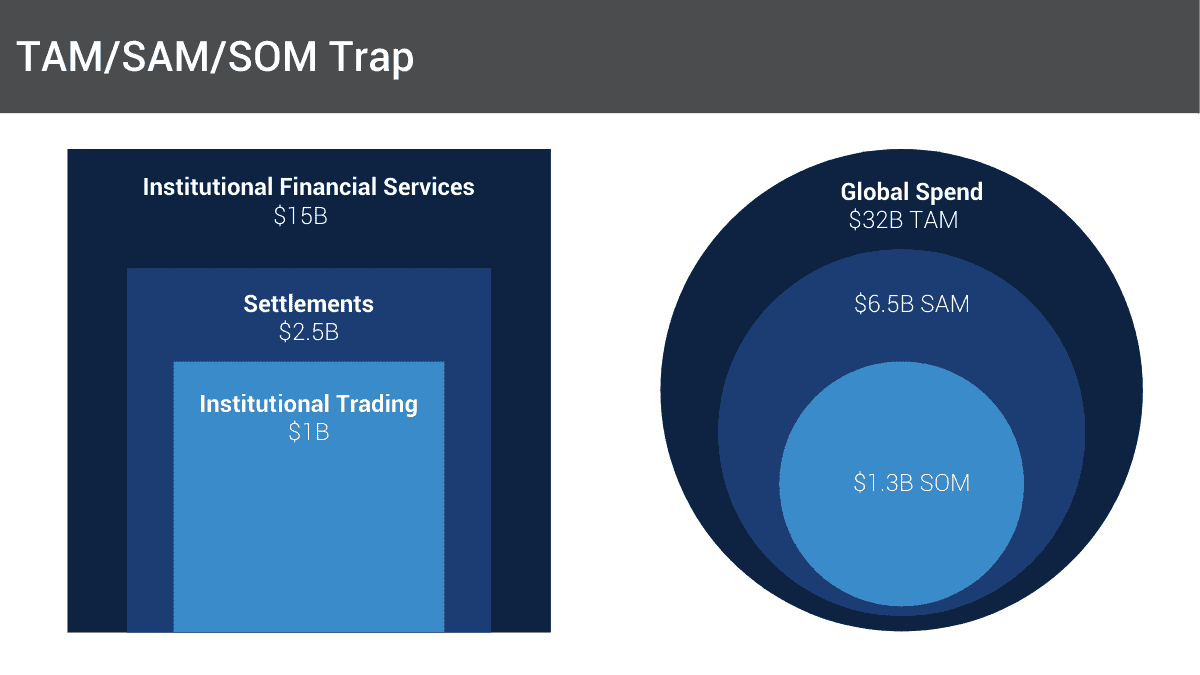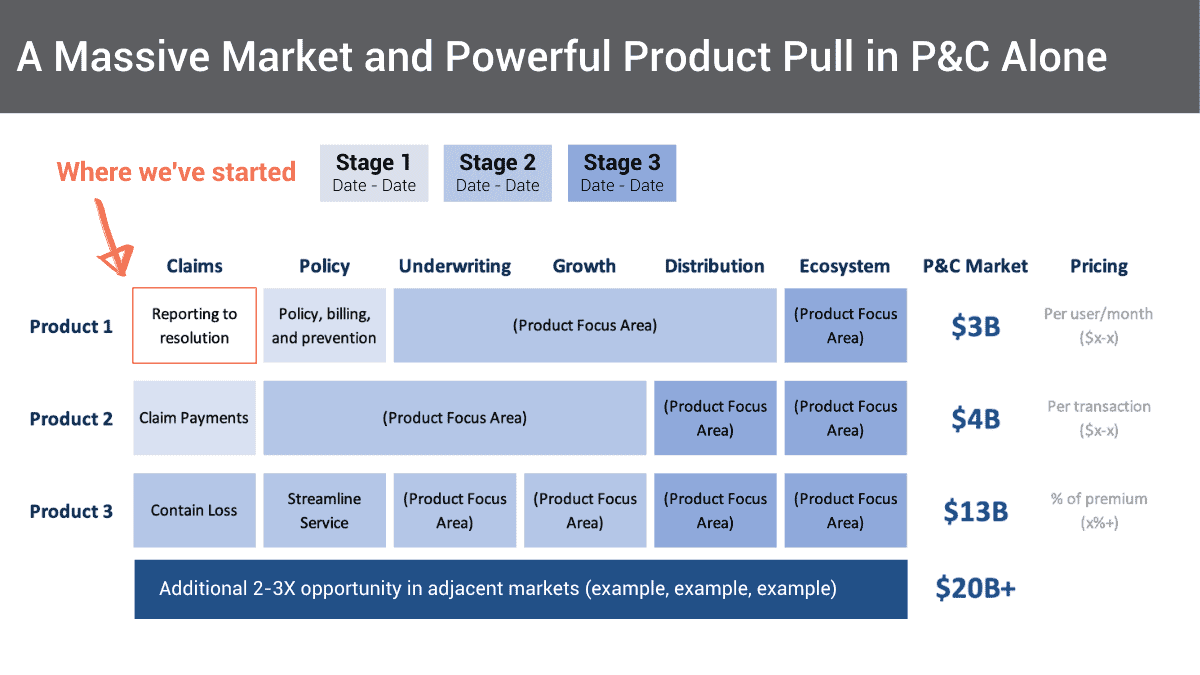“The market size slide is one of the most commonly wasted slides in a pitch deck,” says Richard Dulude, Underscore VC Co-founder and Partner.
While founders know they need to discuss their market opportunity, they often articulate it in a less-than-compelling way, falling into what we call the “TAM/SAM/SOM Trap.” (More on that later.)
Market sizing is challenging. And frankly, it’s often wrong—rarely does anyone know what a market will look like in five to seven years.
Especially in the earliest stages of building a company, you’re probably still testing out pricing, honing your Minimum Viable Segment, and fine-tuning your value proposition. There is still more to learn about your market.
Yet you still need to find a way to show that you’re targeting a massive opportunity. After all, to build a viable (and venture backable) business, there must be a big enough market of customers who will pay for your solution.
In this video, Richard shares tips to create a great market size slide.
In a pitch, you must communicate it in one clear, concise slide. In this article, we’ll walk through the two primary ways to size a market, our strong recommendation for how to go about it, and some anonymized examples of market size slides from real pitch decks we’ve received.
Two Ways to Size a Market
There are two ways to estimate market size. Spoiler alert: One is far more compelling than the other.
- Top-Down Market Sizing: Pulling existing data from analysts like Gartner or Forrester and estimating a market’s value.
- Bottom-Up Market Sizing: Proving your market customer by customer—defining your product’s price, estimating the number of prospective customers, and doing the math.
While top-down market sizing can be directionally helpful, it rarely predicts your specific market’s true nature. Just because you can use this approach, it doesn’t mean you should.
Startup Secret: To estimate your market size, take a bottom-up approach.
Your market size is not a vague dollar amount. It’s the number of customers that you can realistically reach who will actually pay for your product. You can best articulate that through bottom-up market sizing.
The Significance of Your Approach
You’ve got limited time and space in a pitch to prove your business’ potential. Every slide is an opportunity to showcase your vision, strategic thinking, and conviction. That includes your market size slide.
“There’s so much wrapped up in market sizing, and people totally miss it,” says Richard. “It includes pricing, the target customer, the value provided, how you extract revenue—that tells you everything about a company’s business model.”
Market sizing allows you to double click into an initial segment, and then shows how you plan to expand and capture more customers and their dollars (i.e., growth!).
Don’t waste this slide by throwing out some random number from an analyst report.
Why Choose Bottom-Up
Many founders fall into the TAM/SAM/SOM Trap when creating a market size slide. That means measuring your market size by:
- Total Available Market (TAM) focuses on the size of the total market.
- Serviceable Available Market (SAM) focuses on the segment applicable for your tech or service.
- Serviceable Obtainable Market (SOM) focuses on the market subsegment that you could realistically reach given limitations like location, competition, sales channels, team capacity, etc.
While top-down market sizing might be quick and straightforward, the data is often arbitrary and unreliable. And because you didn’t conduct this research yourself, it’s difficult to verify or explain in a pitch.
Here are real examples from recent pitches we heard. These market-size slides don’t convey any unique information about the startups they represent—no strategy, critical thinking, or customer insight.

Why do people take this approach, you might wonder? “It’s faster and easier,” says Richard. “Founders often throw in TAM, SAM, and SOM just to add something. But those numbers are useless, in my opinion. How did you get there? That’s what matters.”
Top-down market sizing sounds like this: “The global smart healthcare market was worth $144B in 2019, and we think we can reach 10% of this market in 2021, meaning we’re targeting a $14B market opportunity.”
Bottom-up market sizing enables you to say: “We’re going to sell our product to doctors in hospitals that use this specific critical care application, starting in New England. There are about 175 hospitals with roughly 80 doctors currently using this kind of application. The average selling price will be $3,500 per doctor per year. That gives us a $50M market to begin with, with the opportunity to expand regionally.”
How to Bottom-Up Market Size
Put simply:
Bottom-up market sizing = [# of Customers] * [Price They’re Willing to Pay]
Like in math class, be sure to show your work. Think through:
- Who is your specific customer?
- How many of them are there?
- How many of them can you realistically reach?
- At what price will they buy?
- Then, perhaps the most challenging: How many will buy from you?
When thinking about how many customers will actually buy your product, consider competitor market share, how strong the customer’s pain is, and any customer feedback you collect via focus groups, surveys, interviews, etc.
Bottom-up market sizing shows:
- You know who is in your Minimum Viable Segment.
- You understand what a customer is worth.
- You can estimate how many of those customers are out there.
- You’ve thought about how you will realistically reach them.
- You have an idea of how you will expand to drive growth.
When you have all this information, you can target your customers more effectively, and you’re well-positioned to go to market.
This should go without saying, but once you’ve done your bottom-up market sizing, be sure that the rest of your pitch and pitch deck include this data and focus on the same target customer. Consistency is key.
A Real Example of a Great Market Size Slide
The formula is simple. But what does it look like in practice? Here’s one of our favorite examples of a market size slide (anonymized for privacy), so you can see how it’s done.

In fundraising, your process is the proof. While bottom-up market sizing can be harder and more time-consuming, it signals clear, strategic thinking when it comes to your business. You’ve done your research, you know your customer, you understand your value to them, and you have an idea of how much they would pay for your product.
Those are the kinds of signals you want to send to an investor.














